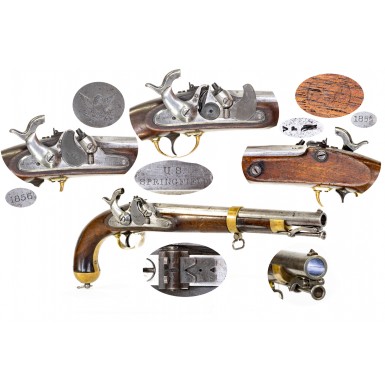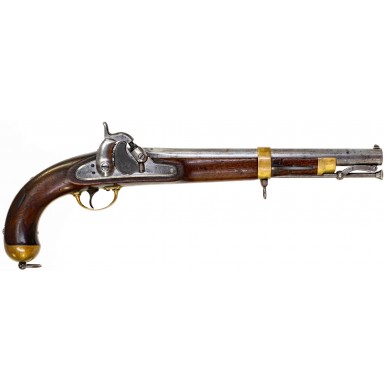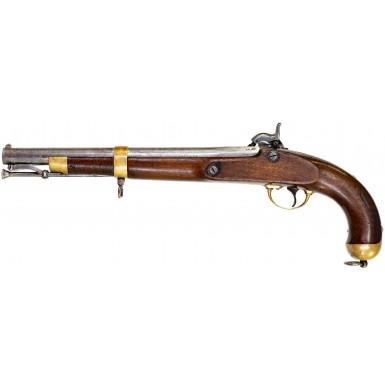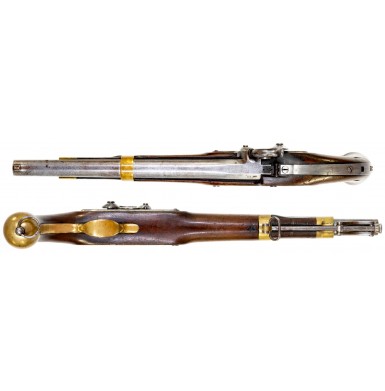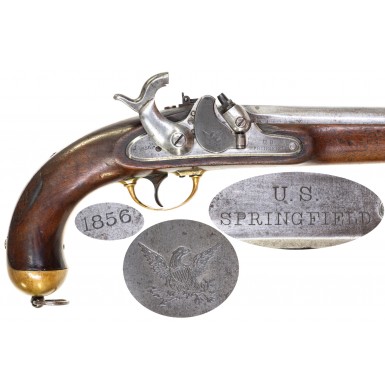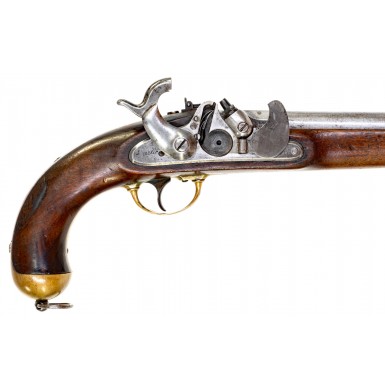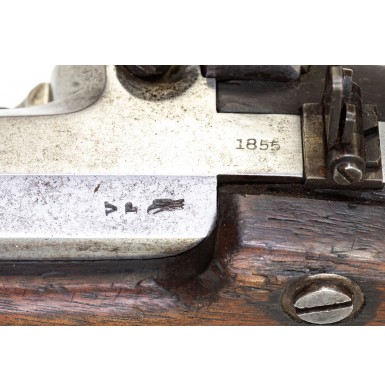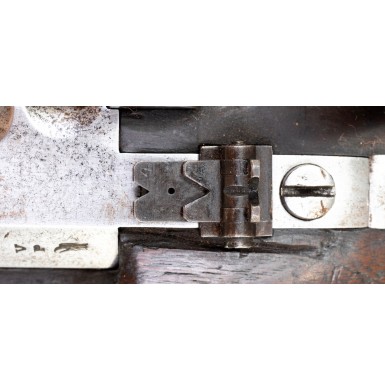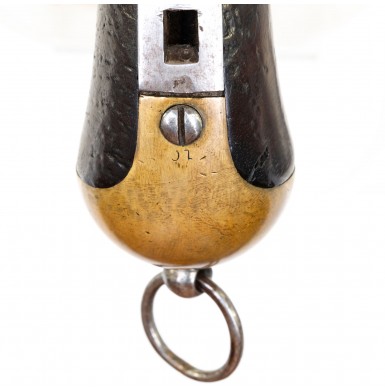This is a VERY GOOD condition example of the US Model 1855 Pistol Carbine. The Pistol Carbine was a classic example of the pre-Civil War US Ordnance Department’s inability to be forward thinkers and look at current and emerging technology when it came to firearms design. Even though much more advanced breech loading carbines and revolvers were already in use by the US military, like the Jenks Naval Carbine, the several models of Sharps’ patent carbines and various Colt’s patent repeating revolvers, the Ordnance Department chose a design that was clearly a step backwards – a single shot, muzzleloading pistol carbine with a detachable shoulder stock. The end result was a weapon that was neither fish nor fowl, an oversized and ungainly pistol or an overly short-barreled carbine with a shaky attachable stock.
The Ordnance Department intended that new the weapon would be issued to the cavalry and used as a pistol when mounted and a carbine when dismounted. The gun was to be carried in the typical pommel holsters of the day, with the pistol in one and the butt stock in the other. US Secretary of War Jefferson Davis approved the gun on July 5, 1855, along with the rest of the Model 1855 family of Maynard automatic priming small arms. Since the Federal Government operated on a fiscal year system, the gun was actually adopted five days into fiscal year 1856. This explains why Ordnance Department records show no deliveries into store of Model 1855 Pistol Carbines in 1855. The armories also maintained their records and booking keeping on a fiscal year basis, but dated their manufacturing of parts, such as locks and barrels, on a calendar year basis. The Springfield Armory delivered a total of 4,021 of the Model 1855 Pistol Carbines to the Ordnance Department during its brief production run. In fiscal year 1856 a total of 2,710 were delivered into stores and in fiscal year 1857 an additional 1,311 were delivered.
The first issues were to a squadron of cavalry from each of the 1st and 2nd US Cavalry Regiments. The guns were far from successful or popular in the field, and no further pistol-carbines were manufactured after fiscal year 1857. In 1858, the pistol-carbine was also tentatively issued to some light artillery units for trials, with the thinking that is might be a handy weapon for those troops, than a more cumbersome carbine or musketoon. However, it was not popular or successful in that role either. Eventually, the Ordnance Department finally saw a glimpse of the future and proceeded to issue revolving pistols to the cavalry and undertook additional trials of breech loading carbines.
As of October 1860, some 3,022 of the Model 1855 Pistol Carbines were in storage at various arsenals, with only nine 992 being in the field. However, the outbreak of the American Civil War created such a pressing need for small arms that most of these pistol carbines were issued, at least on a temporary basis. According to George Moller’s research, elven different companies of US cavalry were completely or at least partially armed with the Model 1855 Pistol Carbine during the first part of the Civil War. John D. McAulay’s research indicates that as late as the 31 December 1862 quarterly field reports, slightly less than 400 of the Model 1855 Pistol Carbines were still in service in the field. The regiments listed in that report, still carrying the Pistol Carbine at the end of 1862, as well as the number of guns that they had in service during the quarter ending 31 December 1862 include the 9th Illinois Volunteer Cavalry (27), the 1st Indiana Volunteer Cavalry (41), 2nd Kansas Volunteer Cavalry (53), 5th Kansas Volunteer Cavalry (76), 6th Kansas Volunteer Cavalry (61), 4th Missouri Volunteer Cavalry (10), 11th New York Volunteer Cavalry (59), 1st West Virginia Volunteer Cavalry (5), 2ndWest Virginia Volunteer Cavalry (66).
Eventually, the guns were withdrawn from service as more practical weapons became available. Despite the fact that the guns were obsolete from the day they were adopted, as late as 1880 some of the Pistol Carbines were still in government storage, as some 332 were sold at auction as surplus from the New York Arsenal in that year.
The US Model 1855 Pistol Carbine has the dubious honor of being the last single-shot percussion handgun to be issued to the US military, at a time when percussion revolvers were the standard of the day, and metallic cartridge revolvers were beginning to emerge. The gun was just under 18” in overall length with a 12” .58 caliber barrel, rifled with the traditional Springfield Armory three-groove rifling. The gun used a reduced sized version of the Maynard automated “tape primer” lock that was also used on both the Model 1855 Rifle and Rifle Musket. Although all previous sing-shot pistols had utilized a roundball projectile, the new Model 1855 Pistol Carbine used the expanding base, .58 conical projectile used in the US Model 1855 Rifle, Rifle Musket and Carbine. The only substantial difference was a reduction in the powder charge from 60 grains for the longarms to 40 grains for the pistol carbine. Like most arms produced at the National Armories during that time frame, the gun was polished to “National Armory Bright”. It was mounted with brass furniture and a walnut stock. The butt of the pistol carbine had a large swivel ring, allowing either a lanyard or carbine sling to be attached. A sling swivel was also mounted on the bottom of the single brass barrel band, as well as in the toe line of the detachable buttstock. The pistol featured a captive ramrod that was retained by a swinging link system, similar to the pattern used on the US Model 1842 pistol and the earlier version of the Model 1847 Cavalry Carbine. Why this system was adopted, when it had been universally despised on the Model 1847 Carbine is somewhat of a mystery. A large iron front sight was installed very close to the muzzle and a multi-leaf rear sight was graduated for use at 100, 200, 300 and 400 yards. The 300-yard graduation was provided via a small peephole in the 400-yard leaf. The iron backstrap was cut to allow the attachment of a removable shoulder stock, which was typically numbered to the gun. The guns and stocks were batch numbered from 1-20, with the numbers stamped into the top rear of the brass butt cap and into the lower part of the buttstock’s brass yoke.
This particular US Model 1855 Pistol Carbine is in VERY GOOD condition and like most surviving examples is not accompanied by the elusive original detachable buttstock. The gun is 100% complete and correct and remains in very nice condition with clear markings on all of the metal. The gun has a salt and pepper patina of medium pewter gray with scattered freckles and patches of dark age discoloration over its entire length. The barrel is mostly smooth, with only some scattered light patches of light pinpricking present, primarily in the area around the breech of the pistol carbine and near the muzzle. The top of the barrel tang is clearly dated 1855 and the left breech flat is marked with very crisp V / P / {EAGLE HEAD} proof and inspection marks. The lock has a lightly cleaned pewter gray color similar to the barrel and shows the same scattered surface oxidation and discoloration. The lock is dated 1856 in a single horizontal line behind the hammer. Mismatched dates by a single year are not uncommon on arsenal produced arms, as components produced and dated in the previous year were not discarded when the calendar year changed, rather they were used up as needed without any particular regard to matching lock and barrel dates. Forward of the tape primer door the lock is marked in two horizontal lines: U. S. / SPRINGFIELD. The tape primer door is a slightly darker, smokier gray color than the balance of the gun and is crisply marked with the usual {Spread-Winged Eagle}, with the usual Springfield five arrows in one talon and olive branches in the other. The tape primer lock mechanism is 100% complete and remains fully functional. The lock of the pistol carbine remains mechanically excellent and functions crisply on all positions. The original multi-leaf rear sight is in place on the barrel tang and operates smoothly. The sight retains much of its original blued finish, which contrasts nicely with the bright steel of the barrel. The original swivel ring is in place on the butt cap of the pistol and the original captive ramrod is in place under the barrel. The bore of the pistol carbine is in VERY GOOD condition as well. It is mostly bright, with very good rifling and shows some lightly scattered light to moderate pitting along its length, along with moderate amounts of oxidation. The brass furniture has an attractive dull butterscotch patina that does not indicate any recent cleaning. The brass butt cap is marked with the mating number 10 indicating that it was intended to mate with butt stock number “10”. The walnut stock is in about VERY GOOD condition as well, particularly for a pistol carbine. The stock is full-length and without any breaks or repairs. This is unusual for these carbines, as they are often found with broken or severely damaged stocks, particularly through the grip area where the stress of the detachable buttstock tends to cause cracking. In this case, the grip does show the curved indentations from the yoke of the buttstock, marks that are typically encountered on pistol carbines that have spent most of their lives with the buttstock attached but breaks or repairs. The stock shows a couple of areas of chipped loss. One is sliver missing along the off side of the breech plug tang, running slightly more than the length of the rear sight base. The other is a small chip missing from the top edge of the lock mortise, directly in front of the bolster. There is a soft but legible script JS cartouche on the stock flat opposite the lock. This is the mark of Springfield Armory sub-inspector James Stillman, who worked at the arsenal from 1835 to 1891, the longest serving employee of the arsenal. During most of his tenure at the arsenal he the foreman of the stocking department, a position that he held for fifty year. He also inspected arms from time to time over about a twelve-year period, with most of his inspections made between 1847 and 1860, at which time he inspected US Model 1842 Muskets, Model 1847 musketoons, Model 1851 Cadet Muskets and Model 1855 rifle muskets and pistol carbines. The stock shows moderate wear and may have been lightly sanded as the counterpane shows some light rounding to the sharp edges. The lock mortise still retains reasonably strong edges, and the gun shows good lines throughout. As would be expected, the stock of the carbine shows numerous scattered bumps, dings and mars from use and handling, with all of this is appearing to be honest wear. The wood to metal fit of the carbine is quite good throughout.
Overall, this is a very solid example of the US Model 1855 Pistol Carbine. This example shows moderate amounts of real-world use but remains complete and correct example, with only the buttstock missing. The gun displays very well and is in much better condition than most of these fairly scarce pistol carbines are usually found in. These unique guns fit into both the Civil War martial handgun and carbine categories in terms of collecting. They are also only the second of three handguns to be produced in any significant quantity at the Springfield Armory, with the earlier pistol being the Model 1817 flintlock pistol and the latter being the Model 1911. The US Model 1855 Pistol Carbine was made in rather limited quantities, making them relatively scarce on the collector market. This is a nice solid example and that is priced very fairly and would be a nice addition to any collection of Civil War era US military arms.

